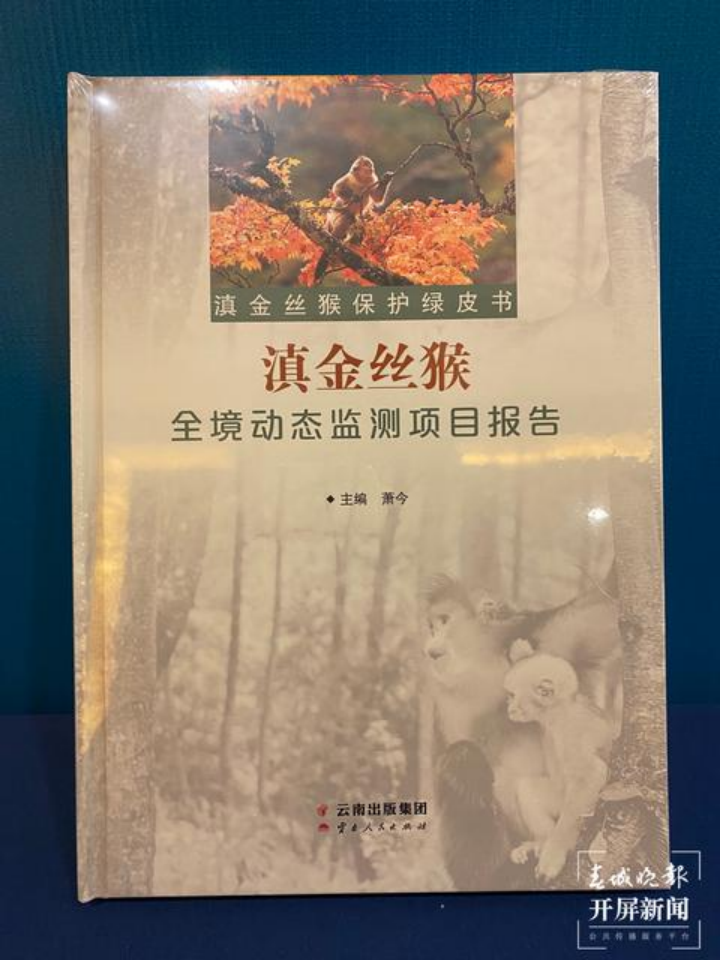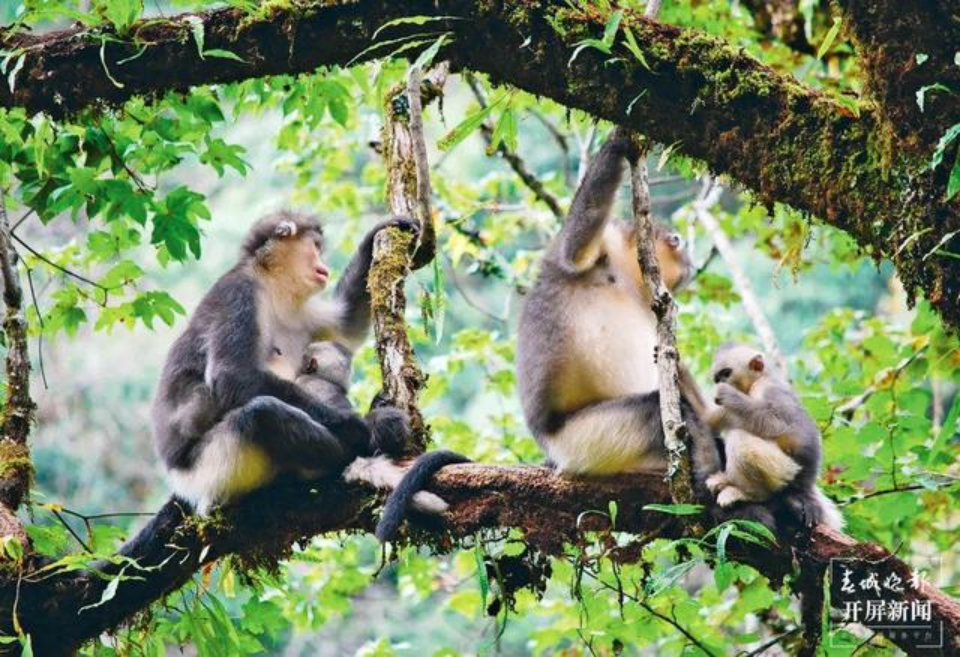The population of Yunnan snub-nosed monkeys has increased to 3,845 individuals in 23 groups. The Green Book on the Conservation of Yunnan Snub-nosed Monkeys was first published in Kunming.
The population of Yunnan snub-nosed monkeys has increased to 3,845 individuals in 23 groups. The Green Book on the Conservation of Yunnan Snub-nosed Monkeys was first published in Kunming.
Yunnan snub-nosed monkey conservation has yielded significant results, with the population increasing to 3,845 individuals in 23 groups. On April 28, 2021, the launch ceremony of the Green Book on the Conservation of Yunnan Snub-nosed Monkeys was held in Kunming. This is the result of a comprehensive dynamic monitoring project of Yunnan snub-nosed monkeys across the province, guided by the Yunnan Provincial Forestry and Grassland Bureau and coordinated by the SEE (Southwest) Center. For many years, numerous organizations in Yunnan, from government and non-profit organizations to the public, have participated in this project. 

▲Launch ceremony scene
Three stages of Yunnan snub-nosed monkey conservation work
The Yunnan snub-nosed monkey is a flagship and umbrella species inhabiting the "Three Parallel Rivers" World Natural Heritage site, and is also a rare and endangered wild animal unique to China. After 2005, the population size, number of individuals, and habitat area of Yunnan snub-nosed monkeys increased and improved, fully demonstrating the significant improvement and overall achievements of the natural reserve management capabilities. The population has increased from approximately 13 groups and 1000 to 1500 individuals in 1996, to 18 groups and 3000 individuals in the 2016 survey, and now to 23 groups and 3845 individuals.
At the press conference, Xiang Ruwu, director of the Wild Plants and Animals Protection Department of the Yunnan Provincial Forestry and Grassland Bureau, introduced that since Yunnan established its first Yunnan snub-nosed monkey nature reserve in 1983, the government has continuously increased investment, formulated policies, and promoted the protection of Yunnan snub-nosed monkeys.
The conservation of Yunnan snub-nosed monkeys has gone through three stages. From the first discovery of wild Yunnan snub-nosed monkey populations in 1979 to 2000, the population size and number of individuals were unstable. The Chinese government signed the international Convention on Biological Diversity in 1992. Around 2000, Yunnan Province began to fully implement biodiversity conservation actions. In 1998, the state first launched the natural forest protection project in Northwest Yunnan, and the wild plants and animals and nature reserve construction project was fully launched. The expansion of the Baima Snow Mountain National Nature Reserve was also completed in 2000.
In the following years, the Yunling Provincial Nature Reserve was established, the Tianchi National Nature Reserve was approved by the State Council, and the "Three Parallel Rivers" World Natural Heritage site was successfully declared. The activity range of Yunnan snub-nosed monkeys in Yunnan was basically included in the protection range, and the adjacent Tibetan population also had the protection of the Mangkang National Nature Reserve. This was a period of comprehensive launch of reserve construction. 

▲Tianchi Reserve, distribution area of Yunnan snub-nosed monkeys in Tianzishan (Image/Yunnan People's Publishing House)
In the third stage, in 2010, the Yunnan Provincial Forestry Department and the Science and Technology Department jointly compiled the Outline of the Yunnan Provincial Plan for the Rescue and Protection of Extremely Small Populations of Species (2010-2020), which included the Yunnan snub-nosed monkey. Yunnan took the lead in the country in carrying out the rescue and protection of extremely small populations of wild species, and in 2015 launched the Yunnan Provincial Conservation Action Plan for Yunnan Snub-nosed Monkeys (2015-2020).
In order to protect the Yunnan snub-nosed monkeys, their habitat, and the entire ecological environment, since the 1980s, government forestry departments, scientists, and other environmental protection organizations have organized several investigations to conduct baseline surveys for the protection of Yunnan snub-nosed monkeys. However, due to various reasons, data on the population size, population dynamics, habitat conditions, conservation management effectiveness, threats, and community needs were incomplete.
Yunnan is a province with high biodiversity in China. On only 4.1% of the country's land area, the number of mammals, birds, insects, and higher plants accounts for more than 50% of the total number of similar species in China. The various nature reserves for Yunnan snub-nosed monkeys have set an example for their protection. "Facing other extremely small populations and endangered rare species, our conservation work has a long way to go. Our government agencies will continue to implement the Biodiversity Conservation Strategy and Action Plan." Xiang Ruwu said.
Professionals from various nature reserves are the main force in implementing scientific research and monitoring teams
The successful breeding and growth of Yunnan snub-nosed monkeys is due to the extensive participation of government departments, conservation managers, scientists, non-governmental environmentalists, and community residents. The Green Book on the Conservation of Yunnan Snub-nosed Monkeys takes Yunnan's flagship species, the Yunnan snub-nosed monkey, as an example to showcase the hardships and achievements of biodiversity conservation in Yunnan over the past 40 years, demonstrating Yunnan's unique advantages and value to the world. It also adds a touch of brilliance and responsibility to the upcoming global biodiversity conference in Kunming. 

▲The Green Book on the Conservation of Yunnan Snub-nosed Monkeys is officially published and released
At the press conference, Xiao Jin, the book's chief editor, secretary-general of the SEE Southwest Project Center, and overall coordinator of the comprehensive dynamic monitoring of Yunnan snub-nosed monkeys, introduced that the Green Book on the Conservation of Yunnan Snub-nosed Monkeys makes a detailed comparative analysis of the historically recorded populations, the number of individuals from previous surveys, and the number of individuals from this monitoring survey, providing detailed information. This is the first time in China that the complete distribution range, population size, and habitat conditions of Yunnan snub-nosed monkeys have been published. This monitoring survey adopts a collaborative approach involving government agencies, non-profit organizations, university experts, conservation professionals, and community residents, and its experience is worth sharing in monitoring and surveying widely distributed wild animals.
Xiao Jin said that the most important foundation for the success of the project is that professionals from various nature reserves have become the main force in implementing scientific research and monitoring teams. Based on the methods suggested by scientists, using nearly 40 years of accumulated experience in nature conservation, and utilizing the knowledge of generations who have coexisted with Yunnan snub-nosed monkeys, first-hand data and information were provided for the monitoring and investigation of various populations, increasing the accumulation of knowledge about the history of Yunnan snub-nosed monkey conservation, their living environment, and community culture.
“This monitoring survey of Yunnan snub-nosed monkeys has many highlights worth summarizing,” Xiao Jin said. In the two-year survey, the most innovative aspect was the adoption of a survey method involving government + non-profit organizations + experts + conservation professionals + community residents. This new and scientifically organized approach yielded more reliable data in the complex natural conditions of high-altitude mountainous areas, and is worth promoting.
This survey is also the first complete survey of all populations of Yunnan snub-nosed monkeys in China, and is a test of the quality of the ecosystem in the distribution area of Yunnan snub-nosed monkeys. The survey data will provide a scientific basis for assessing the quality of Yunnan snub-nosed monkey habitats, formulating targeted conservation measures, promoting population growth and habitat improvement, and community development. 

▲Yunnan snub-nosed monkey (Image/Yunnan People's Publishing House)
The public release of information during the survey further promoted public attention to the conservation of Yunnan snub-nosed monkeys, increasing public understanding of the distribution area, the current status and effectiveness of the work of conservation organizations. The relatively systematic and complete information archive on the population size and habitat status of Yunnan snub-nosed monkeys in Yunnan Province formed by the survey has laid a scientific foundation for the implementation of various conservation actions and the conduct of fundamental research.
To this end, the "Dian Golden Monkey Conservation Green Book" integrates the perspectives of conservation professionals, community residents, village cadres, scientists, and non-governmental organizations, providing a comprehensive account of the history, achievements, and current status of conservation, and proposing suggestions for conservation strategies and specific measures to address new challenges to conservation and development.
Results of the first-ever nationwide synchronized dynamic monitoring
Historically, the Dian golden monkey's habitat was sparsely populated, and its whereabouts were little known. In 1985, the Kunming Institute of Zoology discovered six populations between Deqin and Weixi in the Baima Snow Mountain. In 1996, only 13 of the 20 known Dian golden monkey groups were confirmed, with a population of between 1000 and 1500. The next nationwide survey was conducted from 1999 to 2002, monitoring populations from Mangkang in Tibet to the Malong Mountain in the Yunling Nature Reserve, recording 13 monkey groups with a population of 1200 to 1700. However, this survey found that five populations had disappeared, indicating an unfavorable trend.
In the following years, the conservation of Dian golden monkeys became a joint effort of various government departments and nature reserve managers, as well as private individuals.
According to Xiang Ruwu, to effectively protect Dian golden monkeys, the Provincial Forestry and Grassland Bureau implemented the "Yunnan Province Biodiversity Conservation Strategy and Action Plan" (2012-2030), adhering to the principles of prioritizing conservation, sustainable utilization, public participation, and benefit sharing. Therefore, when the Alxa SEE Southwest Project Center, in collaboration with research institutions, proposed a comprehensive survey of Dian golden monkeys, the then Yunnan Provincial Forestry Department approved the proposal and named the project: "Dian Golden Monkey Nationwide Dynamic Monitoring Project". Due to the involvement of multiple parties, the project achieved excellent results, clarifying the population size, habitat status, and community conservation situation of Dian golden monkeys. According to the monitoring results, the Dian golden monkey population increased from approximately 13 groups and 1000-1500 individuals in 1996, to 18 groups and 3000 individuals in the 2016 survey, and now to approximately 23 groups and 3845 individuals (median of 3360-4330). 

▲Yunnan snub-nosed monkey (Image/Yunnan People's Publishing House)
Since 2016, the Alxa SEE Southwest Project Center, in collaboration with research institutions, has proposed a comprehensive survey of Dian golden monkeys. In 2017, the Alxa SEE Ecological Association and the Beijing Enterprise Environmental Protection Foundation donated 1 million yuan in seed funding. The Yunnan Provincial Forestry Department approved the proposal and named the project: "Dian Golden Monkey Nationwide Dynamic Monitoring Project". This monitoring initiative was led by government departments, involving private environmental organizations and research institutions, and implemented by various nature reserves with Dian golden monkey populations, commencing in the autumn and winter of 2017.
Due to the involvement of multiple parties, the project achieved excellent results, clarifying the population size, habitat status, and community conservation situation of Dian golden monkeys. This project was the first ever to establish a comprehensive baseline database for the history of Dian golden monkey research and conservation, population size, distribution area, living environment, genetic gene pool, and community livelihoods, making a beneficial attempt at ecological conservation, cross-disciplinary research, and ecological civilization construction.
Yang Yuming, a professor at the Yunnan Provincial Academy of Forestry Sciences and a global biodiversity expert, stated at the launch ceremony that the "Dian Golden Monkey Conservation Green Book" represents the results of the first nationwide synchronized dynamic monitoring of Dian golden monkey populations since their discovery, filling the gap in scientific baseline data for nationwide dynamic monitoring of Dian golden monkeys and recording the entire process of comprehensive and systematic monitoring and assessment of Dian golden monkey populations.
"Searching for wild Dian golden monkeys and ensuring their protection has been the goal of four generations of scientists, who have tirelessly searched for and studied Dian golden monkeys in high-altitude forests, even at the cost of their lives." Xiao Jin said that subsequent researchers, protectors, and the public can clearly see from the book the historical outline of searching for and protecting the beautiful Dian golden monkeys, the changes and fluctuations of various influencing factors in space and time, the tremendous achievements after the ban on natural forest logging and the implementation of conservation policies, and the long-term influence of the participation of grassroots researchers, protectors, and community residents in conservation.
At the launch ceremony, Qian Xiaohua, the sixth president of the Alxa SEE Ecological Association, and Zhang Li, secretary-general of the Beijing Enterprise Environmental Protection Foundation, delivered speeches. They elaborated on the significance of the Dian golden monkey nationwide dynamic monitoring project from the perspectives of entrepreneurs and non-profit organizations, respectively, and expressed their sincere gratitude and congratulations to the various levels of conservation management departments, research institutions, private environmental organizations, and community residents who have contributed to the conservation of Dian golden monkeys.




 Wechat Official Account
Wechat Official Account